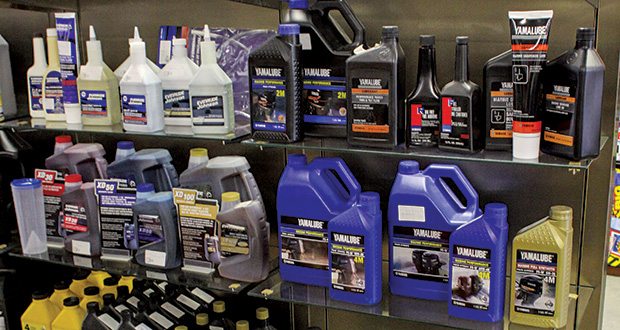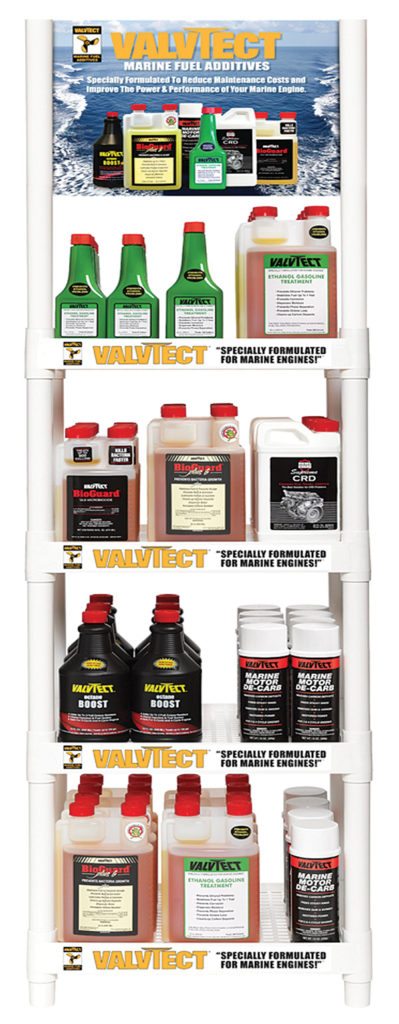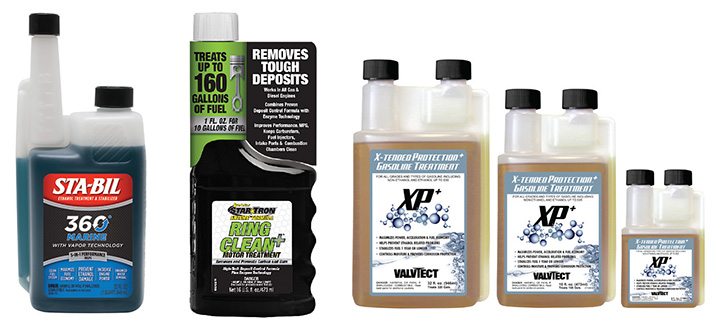Additives offer fuel solutions

But be wary of unrealistic claims, manufacturers say
There are plenty of additives out there for the marine industry, promising to solve all of your fuel woes.
But with little in the way of regulation or consistent, reliable testing, boaters and service personnel alike need to be cautious about what they use and recommend, manufacturers say.
“Everybody makes a lot of claims, but in the end it’s ‘buyer beware,’” said Dave Grochocki, vice president of operations for ValvTect Petroleum Products. “If it sounds unbelievable, it probably is.”
For example, any additive maker that claims its products remove ethanol or reverse phase separation is talking about something that isn’t scientifically possible.
The internet has made it possible for companies to more easily find a buying audience for their products, but it’s also made it tougher to sell a bad product that doesn’t achieve what it claims to. Spend a few minutes with Google typing in product names and you’re going to get a pretty good read on the quality of a product.
“In the old days you could maybe hide, but today if you don’t have a good product it gets exposed instantly,” said Greg Dornau, executive vice president, Star brite. “From the consumer’s point of view, I don’t think they’ve ever been able to get better, more on-the-spot information. The days of having a top-selling product that doesn’t work are pretty close to long gone.”
Once a manufacturer has been in the market for several years – as many of the leading additive suppliers have been – it’s probably a good sign the products get the job done.
“You have a number of products that have been around for years, top products,” Dornau said. “You can generally have faith in a product that’s been a top seller for five, six, 10 years. The market now is educated and communicates better than it ever has.”
 One of the simplest tests is simply to use or recommend to your buyers those products that are being recommended (or manufactured or marketed) by OEMs, said Tom Bingham, senior director of marketing, Gold Eagle.
One of the simplest tests is simply to use or recommend to your buyers those products that are being recommended (or manufactured or marketed) by OEMs, said Tom Bingham, senior director of marketing, Gold Eagle.
“If engine or boat manufacturers recommend a product, it’s a good product, because they’re the ones who face an irate customer if there’s a problem,” Bingham said.
While various tests exist for additives and fuels, Dornau recommends taking those with a grain of salt.
“We’re always leery of testing because not all tests are accurate, and not all tests are used or applied correctly,” he said. “We see a lot of people in the industry that gravitate to one or two tests that we all use and we all notice that whoever runs the test always comes out on top.”
Many tests can give widely varying results, making them less useful in comparing additives. Plus, many additives are trying to accomplish different goals, and one test can’t measure everything.
“You can sometimes tailor a test to give you the results you want,” Dornau said. “If you’re looking at the testing provided by a company, you really want to look at a wide range of testing.”
For example, Star brite conducts chemical lab testing, live engine bench testing in the lab and fleet tests, where the product is put in boats out on the water.
“When you get into fleet testing, you really get a sense of what a product is going to do in the real world,” Dornau said.
Addressing ethanol
While it’s not the only reason boaters have fuel issues, ethanol is a key player in many of the problems.
(See more on ethanol issues in our reader survey on p. 13)
“When we talk to dealers and we talk to mechanics at the shows, ethanol is still the biggest issue,” Grochocki said. “Everybody has a problem with it. It’s not something that’s going away. If anything, it’s going to get worse.”
Those concerns prompted the creation of ValvTect’s newest additive, X-Tended Protection Plus (or XP+), designed to protect engines from problems that arise when an engine is not used on a regular basis, such as gums, varnish, corrosion and water issues.
“It’s the nature of the beast with storing fuel on boats,” Grochocki said. “Boats sit for a longer period of time than cars do. Same issue you have with any type of recreational vehicle … you run into those issues.”
XP+ contains a stabilizer, proprietary corrosion inhibitor, water dispersant to remove controlled amounts of water and detergents to help clean up carbon deposits.
XP+ is designed to “improve performance as well as taking care of ethanol,” Grochocki said.

Changes over the last decade — such as an increase in ethanol-blended fuels and more slow speed zones — have resulted in higher levels of carbon deposits.
“Everywhere in boating carbon build up is an issue,” Dornau said. “It seems like carbon has become more of a problem in the ethanol fuel era than it was in the old days. … Ethanol fuels, in some cases, evaporate a little bit quicker, so they tend to build up gums and varnishes, a little more water in the fuel. That can lead to extra carbon.”
In an effort to address that, Star brite introduced Ring Clean+ in 2015, which combines carbon removal with the proprietary enzyme mix of its flagship Star Tron product.
“The main chemical is going to be a really strong carbon removal and the enzymes are helping break down things, make it easier to process in the engine,” Dornau said. “It enhances combustion, helps the engine process the water in the fuel as well. We launched it to work in conjunction with Star Tron, which is an every-fill-up product. This is going to be every fourth or fifth tankful depending on your boating habits.”
Gold Eagle is also looking to address ethanol concerns with its new Sta-Bil 360 (an update of the previous Sta-Bil marine product) which it calls the “ultimate protection against ethanol blended fuels.”
Common engine problems “come down to three things — preventing the development of gum in the varnish,” Bingham said. “Second is removing any of those deposits that have developed in the past. Lastly corrosion and the tendency of water to mix with
alcohol/ethanol.
“They’re not all tied to ethanol, but ethanol can exacerbate some of those issues that a boater or any engine owner could face.”
Sta-Bil 360 provides corrosion protection above the fuel line, an industry-first, the company says.
“The key benefit is if you look at a carburetor or in many cases a fuel line, a good fuel additive will protect against corrosion anywhere the fuel touches, but it’s not long-lasting,” Bingham said. “After the fuel goes away, the protection goes away. The 360 technology releases a vapor that deposits a microscopically thin corrosion prevention barrier on metals. So where all that water vapor can attack metals and you can get problems like white rust on aluminum or actual rust on metal parts, the vapor protects those parts whether the fuel is soaking them or not.”
Bingham also offered some caution about buying ethanol-free (E0) fuels in an attempt to avoid ethanol problems.
“Sometimes, disreputable dealers are not actually telling the truth and selling it at a higher price,” he said. “The other problem is that ethanol is an octane enhancer, so some of this fuel that doesn’t have ethanol in it is a very low octane fuel.”




